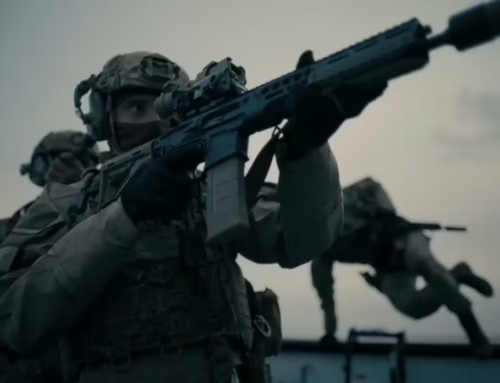In recent years, technology has advanced considerably, and with it, firearms training simulation software has also progressed significantly. For the military and law enforcement sectors, this has proved to be a powerful tool to harness when it comes to training personnel in a cost-effective and efficient way.
However, how effective can firearms training simulators be for firearms training? Can they truly replace conventional training methods? And do they offer advantages that are far beyond those provided by non-simulation experiences?
It’s well-known that real-life combat simply can’t compare with a traditional training environment. Remaining calm in a firefight while making wise decisions and knowing how to effectively communicate with others is never going to be easy.
Firing lasers and shooting at 2D targets can, therefore, never truly prepare military or law enforcement trainees for situations that they are likely to encounter in the course of their duties in the real world. So, can a simulator prepare them any more effectively?
Here, we take a closer look at the research that has been carried out into the effectiveness of simulation software for this purpose, and we also identify the benefits that it offers.
Ongoing Research And Reporting
Research into the effectiveness of simulators for firearms training has been ongoing for almost two decades, with governments and military organisations worldwide investigating the possibilities that the simulated environment could hold for its trainees.
Organisations as diverse as the Naval Postgraduate School in Monterey California, The United States Department Of Defense, The University of Regina in Saskatchewan, Canada, and the Australian Government’s Department of Defence have all carried out their own analyses into the use of firearms training simulation software for military and law enforcement training purposes.
Overall, the reports produced by these various bodies have proven to be positive, with outcomes such as greater cost-effectiveness, improved safety, and high levels of concentration having been found amongst participants in the research.
Safer Than Hands-On Experience
It goes without saying that using firearms training simulators rather than a live-fire hands-on training environment is always going to be safer for the personnel taking part. In even the most health and safety-conscious organisation, there is always the possibility of an accident when using loaded firearms, especially when working with large groups of trainees.
Using firearms training simulation software gives trainees an immersive and realistic environment within which they can practice perfecting their decision-making skills and honing their responses without putting them in any real physical danger.
The Opportunity To Experience Different Scenarios
One limitation that those running hands-on firearms training sessions face is a lack of variety in environments and scenarios. It simply isn’t practical or even possible to take trainees to a wide range of locations to experience using firearms in different situations.
A simulated environment, meanwhile, can easily be adapted to suit a broad range of environmental conditions and scenarios, allowing trainees to experience firearm use in various settings that they would otherwise have been unlikely to experience during their live-fire training.
Time-Saving And Cost-Effective
One of the biggest problems associated with live-fire training is the expense of ammunition. The costs mount up over multiple hands-on firearm training sessions, especially when there are large groups of trainees, and in a world where cost-saving is becoming increasingly important, firearm simulators can represent a valuable expense-cutting solution.
As less money needs to be spent on maintaining a live-fire range, it’s easy to see how simulators can be an affordable long-term option.
Not only can a simulator slash expenses, but it can also save a considerable amount of time. By allowing multiple people to receive training simultaneously in the same location, simulation software significantly cuts the length of time it takes to train multiple recruits without any compromise in the quality of that training.
Full Immersion In The Experience
One perceived drawback of using simulators for firearm training instead of putting recruits into a hands-on live-fire environment is a lack of immersion. There is a school of thought that says trainees must physically experience different conditions and scenarios in person in order to know how to react and respond when faced with a similar situation in the line of duty.
Yet, this is an old and outdated idea that stems from a time when simulation software lacked the advanced technology that is available to developers today.
Modern simulators are designed to be highly specialist and offer a fully immersive experience thanks to quality rendering and graphics. Even the environmental effects that have been integrated into the software are extremely realistic, from water effects and lighting, to shadows and weather conditions, allowing recruits to gain a true perspective of what it will be like to work in changeable and challenging environments when in the real world.
By harnessing the power of mixed and augmented AR and VR (virtual reality), alongside cutting-edge feedback and display technologies, the latest simulators are able to effectively recreate the pressure recruits will experience when in a real-life situation and give them the valuable and much-needed exposure they require to succeed when facing scenarios in the course of their work.
Objective Measurement Of Progress Is Possible
In a hands-on live-fire training session, there is a limit to how far each trainee’s progress can be objectively measured over time. When using a simulator, however, each individual can have their progress measured accurately, with the software recording their every decision, move, and vital statistics as they work through their training.
Using Live-Fire And Simulation Software In Tandem
In general, the bodies carrying out research into the effectiveness of simulation software for firearms training came to the conclusion that simulators offer considerable benefits, not only in terms of cost and time saving, but also in helping to prepare trainees to carry out their duties in a far broader spectrum of scenarios and environments than could ever be achieved through standard hands-on training methods. By using live-fire sessions and simulation software training in tandem, it’s possible to achieve the best possible level of skill and practice that can translate effortlessly into real-world situations.





